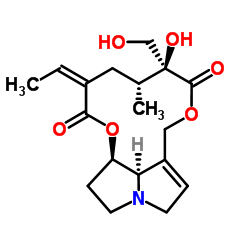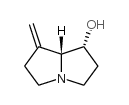480-54-6
| Name | retrorsine |
|---|---|
| Synonyms |
(15Z)-12,18-Dihydroxysenecionan-11,16-dione
[1,6]Dioxacyclododecino[2,3,4-gh]pyrrolizine-2,7-dione, 3-ethylidene-3,4,5,6,9,11,13,14,14a,14b-decahydro-6-hydroxy-6-(hydroxymethyl)-5-methyl-, (3Z,5R,6S,14aR,14bR)- isatidine trans-15-Ethylidene-12b-hydroxy-12a-hydroxymethyl-13b-methylsenec-1-enine b-Longilobine 12,18-dihydroxy-senecionane-11,16-dione 12,18-Dihydroxysenecionan-11,16-dione β-Longilobine cis-Retronecic acid ester of retronecine Retrorsin (3Z,5R,6S,14aR,14bR)-3-Ethylidene-6-hydroxy-6-(hydroxymethyl)-5-methyl-3,4,5,6,9,11,13,14,14a,14b-decahydro[1,6]dioxacyclododecino[2,3,4-gh]pyrrolizine-2,7-dione MFCD00013331 |
| Description | Retrorsine is a naturally occurring toxic pyrrolizidine alkaloid. Retrorsine can bind with DNA and inhibits the proliferative capacity of hepatocytes[1][2]. |
|---|---|
| Related Catalog | |
| In Vitro | Retrorsine (60-240 μM; 24 hours) significantly reduces HSEC-CYP3A4 cells viability, depletes GSH, and increases formation of pyrrole-protein adducts[3]. Cell Viability Assay[3] Cell Line: HSEC-CYP3A4 cells Concentration: 60 μM, 120 μM , 240 μM Incubation Time: 24 hours Result: Significantly decreased cell viability. |
| In Vivo | Retrorsine (30 mg/kg; i.p.; twice) impairs liver regeneration in the PBL model not only by an S or G2/M phase block, but also by a block located before the G1/S transition of the cell cycle[1]. Animal Model: Male Wistar rats (180±20 g), portal branch ligation (PBL) model[1] Dosage: 30 mg/kg Administration: Intraperitoneal injection, twice, separated by 2-week interval Result: Strongly impaired the liver weight gain, protein and DNA synthesis as well as induction of cell cycle related proteins in the regenerating lobes after PBL. |
| References |
| Density | 1.3±0.1 g/cm3 |
|---|---|
| Boiling Point | 583.2±50.0 °C at 760 mmHg |
| Melting Point | 208-211ºC(lit.) |
| Molecular Formula | C18H25NO6 |
| Molecular Weight | 351.394 |
| Flash Point | 306.5±30.1 °C |
| Exact Mass | 351.168182 |
| PSA | 96.30000 |
| LogP | -0.14 |
| Vapour Pressure | 0.0±3.7 mmHg at 25°C |
| Index of Refraction | 1.590 |
CHEMICAL IDENTIFICATION
HEALTH HAZARD DATAACUTE TOXICITY DATA
MUTATION DATA
|
| Symbol |

GHS06 |
|---|---|
| Signal Word | Danger |
| Hazard Statements | H300 |
| Precautionary Statements | P264-P301 + P310 |
| Personal Protective Equipment | Eyeshields;Faceshields;Gloves;type P2 (EN 143) respirator cartridges |
| Hazard Codes | T |
| Risk Phrases | 25 |
| Safety Phrases | S22;S45;S36/S37/S39 |
| RIDADR | UN 1544 |
| RTECS | VH7525000 |
| Packaging Group | II |
| Hazard Class | 6.1(a) |
| Precursor 1 | |
|---|---|
| DownStream 1 | |


